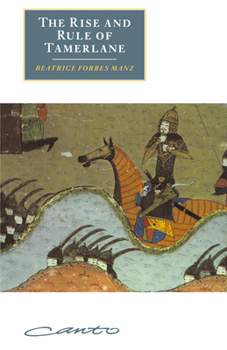The Rise and Rule of Tamerlane
Select Format
Select Condition 
Book Overview
The great nomad conqueror Tamerlane rose to power in 1370 in the ruins of the Mongol Empire and led his armies of conquest from Russia to India, from Turkestan to Anatolia. In this, the first full... This description may be from another edition of this product.
Format:Paperback
Language:English
ISBN:0521633842
ISBN13:9780521633840
Release Date:January 2008
Publisher:Cambridge University Press
Length:248 Pages
Weight:0.80 lbs.
Dimensions:0.6" x 6.4" x 8.5"
Customer Reviews
2 ratings
An important contribution to understanding tribal politics
Published by Thriftbooks.com User , 19 years ago
Temur was born in Transoxania near Samarqand, probably in the 1320s or 1330s. He descended from the Barlas tribe of Chinggis Khan's confederation, which through the adoption of Islam had come in close contact with settled populations and learned to participate in their culture. Although the chronicles written by the Persians during (or soon after) Temur's lifetime suggest that he was a conventional Muslim, a careful reading has revealed that more than a hundred years after the death of Chinggis Khan and the conversion of the Chaghatay Mongol tribes in Transoxania to Islam, Temur and his warriors still continued to observe many of the old pagan practices. Indeed, what was true for their culture and religious practices was also true for their politics. Beatrice Forbes Manz's book The Rise and Rule of Tamerlane is not a biography. She is not interested in the colourful or (as she suggests) fictitious youth of Temur as a sheep-stealer and provides a rather brief account of his rise to power as a warlord in Khorasan and Transoxania in the late fourteenth century. Nor is she interested in the military history and details of Temur's conquests; the conquest of Delhi (1398) and the Battle of Ankara (1402) are described in a line each. Legends of Temur's ruthlessness and persecution of victims (including the pyramids of bloody skulls outside smoking cities) are also not to be found in this work. Instead Manz focuses on analyzing how Temur manipulated the nomadic and political traditions of the Chaghatay in order to take control and power over them, and how he later undermined those traditions and effectively destroyed the independent power of the tribes. The conquests of Temur were quite different from those of Chinggis Khan and predecessors (even though Temur ceaselessly invoked Chinggis as his model). This is partly because the world that Temur conquered was not an alien one, but a known entity, almost all of which had been previously conquered by Mongols. And although by the fourteenth century the power of the Chinggisid dynasty had declined and the Mongol empire had fallen apart, the steppe nomads still retained much of their power and prestige. In fact, the tribal confederation within which Temur rose to power and the world he conquered were the products of the Mongol empire. As aforementioned, these nomads preserved the Mongolian heritage of their ancestors in a new guise suitable to the rule of settled people with whom they were now intimately involved. They were able to constitute themselves as a separate ruling level over the subject population by manipulating both steppe and Islamic traditions and institutions. Manz suggests that it is only from Temur's time that the Turkic people and the traditions of the steppe became truly indigenous to the Middle East. Despite Temur's ambition to approximate and imitate the methods of conquests and career of Chinggis Khan, his own achievements were less substantial. Manz attributes the downfall of Temur's
Rise and Rule of Tamerlane
Published by Thriftbooks.com User , 24 years ago
An excellent scholarly study of the society from which Timur sprang and the empire he created.





